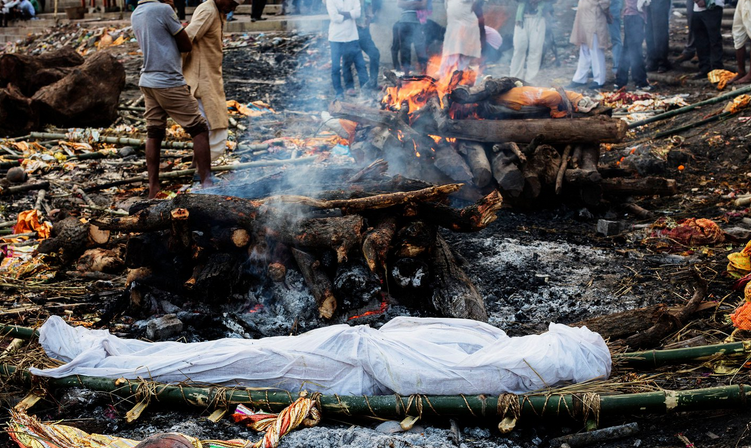
Varanasi is reputed to be the oldest city in the world—and the holiest. On both counts, it looks the part. Its modern name derives from its location in northern India on the left bank of the Ganges River between two tributaries: the Varuna (downstream) and the Assi (upstream). Varanasi’s poetic name, Kashi, means something like “City of Light”. The colonial-era names Benares, Benaras and Banaras are obvious corruptions of Varanasi, adopted by the Britishers (as they are still called) after transliterations of the city’s name through multiple intermediary languages. Conservative Hindu revivalists call the city Kashi; liberal internationalists call the city Baranas; railway timetables respect the old ways, and call it Varanasi.
For as long as anyone can remember, the chief industry in Varanasi has been death. The city is in fact holy to Shiva (“the Destroyer”), the Hindu equivalent of the Greek god Poseidon. You won’t find that parallel made in the standard references, but go to Varanasi and you’ll find it. Shiva carries a trident (still the symbol of Varanasi), keeps a bull as his familiar, is responsible for earthquakes, and has an eye in the middle of his forehead (like Poseidon’s cyclops sons). He is the god, if not exactly of the sea, at least of floods—and remember: the ancient Indo-Europeans originated deep in the interior of Eurasia. Just don’t tell an Indian that Indo-Europeans came from anywhere else but India; you’ll be labelled a perfidious Britisher and have your visa cancelled.
The Philistine appears in every Quadrant.
Click here to subscribe
Those who learned their Greek mythology from the Romans (via the Britishers) may remember Poseidon as the sea god and Hades as the underworld god, but more conscientious students of comparative ethology will remember that all Indo-European underworlds were accessed across a river of death. The Greek river was the Styx, and its Indian equivalent was (and still is) the Ganges. The Greek river of the dead was vaguely remembered to be far off in a distant land; ask the Indians, and they’ll tell you that that distant land was India. And just as the Greek underworld was guarded by the three-headed dog Cerberus, the Indian underworld is guarded by two four-eyed dogs, Sharvara and Shyama. In Varanasi, all dogs are sacred to Shiva.
Most people go to Varanasi to visit the Vishwanath temple, to watch the Ganga Aarti fire ritual, or to die. The Vishwanath temple is the chief temple to Shiva and one of the holiest in India. “Vishwanath” literally means “Lord of the World” in Sanskrit, and the devotees of Shiva (whose Varanasi statue below) consider him to be the chief among Hindu gods. Vaishnavas (devotees of Vishnu) may be more numerous, but Shaivites (devotees of Shiva) are more militant, and Shiva’s trident is certainly more fearsome than Vishnu’s discus. You don’t mess with Shiva the Destroyer.

The Vishwanath temple is, as you would expect, in the old city centre of Varanasi. It is also, as you might not expect, built around a mosque, which is built around an older version of the temple. The mosque was built in 1669 on the orders of Mughal emperor Aurangzeb, who had the original temple (“original” is relative here, in the world’s oldest city) torn down and the mosque built more or less inside it. The rear wall of the old temple remains as the rear wall of the mosque, creating a Hindu equivalent of the Wailing Wall in Jerusalem. The key difference is that while the Al Aqsa Mosque on the Temple Mount is revered as the third-holiest site in Islam (built on the very spot where Mohammed ascended to Heaven), the Gyanvapi mosque in Varanasi is just a neighbourhood mosque—and a little-used one at that.
Still, religious tensions being what they are in India, the country’s Muslim religious authorities cling tenaciously to their property rights, and refuse to allow the repurposing or sale of any mosque. Many Muslim jurists agree: once a mosque, always a mosque. As a result, there is no peaceful solution to the communal conflict at the heart of old Varanasi. The disused Gyanvapi mosque looks like an overgrown jungle temple, given over to the monkeys rather than be sold to the Hindus. Shaivites file around it to access the new temple, glaring resentfully at the minarets as they offer milk to their god. A five-metre fence topped with barbed wire protects the mosque from potential attacks.
It may not be high enough. In 1992 a mob of more than 100,000 angry Hindus tore down a little-used mosque in the small town of Ayodhya—a little-used mosque built over the legendary birthplace of Lord Rama, an avatar of Vishnu (“the Preserver”). The mosque was reputed to have been built in the early sixteenth century by Babur, the founder of the Mughal empire. Nationwide communal violence at the time reportedly took 2000 lives. Islamist terrorists later attacked the disputed site in 2005. Finally, in 2019 India’s Supreme Court ruled that the land belonged to the government, awarded the land to a Vaishnava organisation for the building of a new temple, and ordered that an alternative plot be offered to the state Muslim religious board for the building of a new mosque. In 2020, India’s saffron-clad prime minister Narendra Modi laid the foundation stone for a new temple. Mr Modi hails from Gujarat on the west coast of India, but in India’s parliament he represents the constituency of … Varanasi.
The second thing to do in Varanasi is to attend the Ganga Aarti, once a sacred ritual offering nightly prayers to the goddess of the Ganges, now a series of ticketed shows performed all up and down the river offering nightly prayers to the goddess of the Ganges. The few Western tourists you’ll see in Varanasi who are not anachronistic hippies staying at the cheap pilgrim hostels are all at the Ganga Aarti. The luxury ticket to the Aarti buys you an uncomfortable spot on a huge divan right in front of the loudspeakers; the cheap plastic chairs offer a much more comfortable experience a few metres farther back, with better camera angles to boot. The super-luxury ticket is the catered boat ride up and down the river bank, allowing you to see all the Aartis without losing your hearing to any of them. It may not be very spiritual, but food is served, and the drinks are included.
But the best thing to do in Varanasi, and by far the most popular, is to die—or for those who are already dead, to be cremated. If ancient Varanasi was known as the City of Light, it was probably on account of all the funeral pyres. For the well-to-do, a good old-fashioned body-burning on the banks of the Ganges is still available, even in our world of fire regulations and pollution restrictions. For everyone else, there are gas-fired and electricity-fired crematoriums just adjacent to the river. When floods submerged the usual cremation sites in 2019 and 2022, canny businesses shifted to burning bodies in the narrow alleyways of old Varanasi. It is not known whether the local residents were consulted, but the smart money says No. When it comes to death, the show must go on.
Hindus who die in Varanasi hope to break the cycle of reincarnation and experience moksha, the liberation of the soul. The pilgrims’ lodges that line Varanasi’s eighty-four ghats (river steps) are basic, but cheap. Many are run by charitable organisations. Some of these hospices operate on a strict two-week limit for the terminally ill (if you don’t slide out the back door, you’re kicked out the front, although it’s rumoured that exceptions are made for those who look as if they might vacate voluntarily at a moment’s notice). Others are run more like retirement homes, with the length of stay less certain but the ultimate outcome the same. Either way, it’s a monkish existence, but monks’ rations are perhaps not such a hardship for people who are accustomed to scratching out a meagre living in a country where the average per capita income hovers around $100 a month.
Average incomes in Uttar Pradesh, the state of 200 million people in which Varanasi is located, are closer to $60 a month—and Varanasi sits in the poorer eastern half of the state. It’s a miracle that the city can be governed at all, never mind kept peaceful and (somewhat) orderly. But change is in the air. Mr Modi has showered his home constituency with development projects, and sewage treatment plants have made a vast improvement in the quality of the holy waters of the Ganges. Car-choked streets have made the air itself more acrid than ever, and the funeral pyres don’t help. No one goes to Varanasi to breathe easy. But the ancient Kashi’s current residents may find life a little brighter in the City of Light before they breathe their last.
Salvatore Babones is The Philistine.
 Sign In
Sign In 0 Items (
0 Items ( Search
Search










Thanks for this Salvatore, really interesting. I also like the useful travel tips on the best seating at Ganga Aarti. I’ll try and remember if I get there one day.
The similarities between Greek and Indian mythologies are striking. To Shiva and Poseidon could be added:
. Zeus on Mount Olympus and Indra on Mount Meru, both wielding lightning bolts crafted by smith gods Hephaestus and Tvaster.
. Hermes and Narada, both messengers, sons of Zeus and Brahma respectively.
. The Dioscuri (Castor and Pollux) and Asvins, divine twins noted for horsemanship
. Eos and Usas, both dawn goddesses.
. The Styx and Vaitarna, both rivers which must be crossed to reach the Underworld guarded by Cerberus and Sarvara.
. The Naiads and Apsaras, goddesses of fresh waters.
. The Illiad and the Ramayana, both describing wars started because of abducted women.
. The Illiad and Mahabharata, whose main protagonists, Achilles and Karna, are nearly (but not quite) invincible, whose mothers asked them not to participate in the war described, and whose deaths ended both wars.
. Icarus and Daedalus, and Jatayu and Sampati, flying too close to the sun.
.
No doubt there are more, as well as similarities to Iranian, Baltic, Norse, Celtic and even Hittite myths, due to derivation from a Proto-Indo-European set of myths and legends, the ultimate source of Western culture.
So many vivid pictures Salvatore of the ghats in Varanasi. Thankfully the British put a stop to Suttee, the practise whereby the Hindu widow immolates herself on her husband’s funeral pyre.
History says the Moghuls removed vast treasure from Varanasi after its conquest.
Holy rivers were legendary in Bible times and there is the story of Naaman the leper cleansed in the Jordan
2Kings 5:1, 11, 20, 27; and Luke 4:27.
I visited Varanasi in 1976 and again in 2015. Nothing much had changed. In 1976 we did an early morning cheap tourist boat ride on the Ganges. Our garrulous guide fished two dead babies out of the river for our inspection.. Our later breakfast was never more unappealing. Varanasi the city of romance and horror.